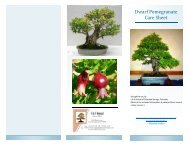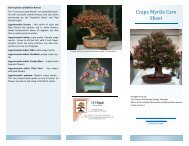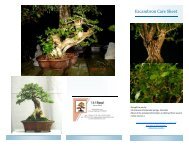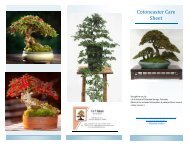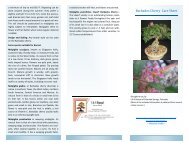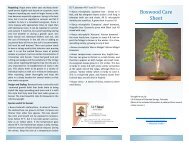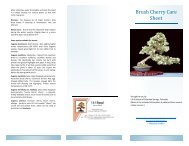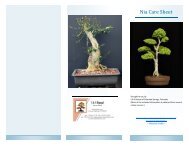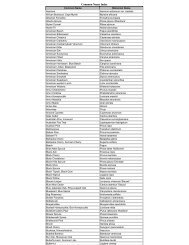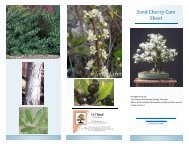Kingsville Boxwood Care Sheet
Kingsville Boxwood Care Sheet
Kingsville Boxwood Care Sheet
You also want an ePaper? Increase the reach of your titles
YUMPU automatically turns print PDFs into web optimized ePapers that Google loves.
is not the matted fibrous roots of potted azaleas or<br />
junipers, but has similar characteristics if it becomes<br />
root bound. It can also be repotted in the<br />
summer or fall if needed and you live in the South,<br />
though you would want to avoid repotting during<br />
the hottest months. When repotting during other<br />
times of the year, try not to cut roots. <strong>Boxwood</strong><br />
prefers well-drained soil mixes and will tolerate<br />
slightly alkaline soil. Use basic low acid bonsai soil<br />
and add an occasional dose of lime to the soil for<br />
optimal health. Add fertilizer and iron to the soil<br />
when repotting. Although not mandatory, <strong>Kingsville</strong>s<br />
like a deeper pot.<br />
Design and Styling: The plant does well in many<br />
bonsai styles and is ideal for shohin, mame and<br />
landscape plantings.<br />
<strong>Kingsville</strong><br />
<strong>Boxwood</strong> <strong>Care</strong><br />
<strong>Sheet</strong><br />
Brought to you by<br />
S & S Bonsai of Colorado Springs, Colorado<br />
(Most of the included information is obtained from several<br />
online sources.)<br />
“Live as if you were to die tomorrow. Learn as if<br />
you were to live forever.”<br />
—Mahatma Gandhi—
The <strong>Kingsville</strong> <strong>Boxwood</strong><br />
(Buxus microphylla x. compacta var. kingsville )<br />
General Information: <strong>Kingsville</strong> <strong>Boxwood</strong>s take<br />
their name from the nursery where it was discovered<br />
in Maryland in 1912. However it was not released<br />
to the public until 1937. This is interesting<br />
since most bonsai websites called it Japanese<br />
<strong>Kingsville</strong> <strong>Boxwood</strong> and it originated here in the<br />
USA. Seems that sellers feel that we need to think<br />
that all our bonsai originate in Japan. In all fairness,<br />
boxwood were introduced to the United States in<br />
1652 and were a favorite from Maryland to North<br />
Carolina. There are about 115 cultivars available<br />
today.<br />
<strong>Kingsville</strong> <strong>Boxwood</strong> belongs to the genus Buxus of<br />
the Buxacae family. This family is widely varied to<br />
include both Pachysandra of ground cover fame as<br />
well as the common boxwoods. <strong>Boxwood</strong>s are evergreen<br />
trees and shrubs with opposite, shortstalked,<br />
undivided leathery leaves. The plant is very<br />
slow growing. The flowers are petal-less. The fruits<br />
are three lobed and when ripe, they explode on<br />
contact. The hardiest boxwoods are the Buxus microphylla,<br />
which includes the <strong>Kingsville</strong> variety. The<br />
wood is very fine grained and durable. The leaves<br />
are dark green in the warmth of the growing season<br />
and turn lime green or even yellowish in colder<br />
weather. The color returns to green in the spring.<br />
Leaves that grow old and turn yellow must be removed.<br />
This boxwood is unique among boxwoods for its<br />
scentless evergreen leaves that are less than 1 inch<br />
long. <strong>Kingsville</strong> Dwarf <strong>Boxwood</strong> is the most sought<br />
after member of the "Buxus" family. It features<br />
dark green, tiny leathery leaves, dense growth habits<br />
and rough bark which are all the features that<br />
make it a good bonsai subject. Branches grow horizontally<br />
making it look like a miniature version of a<br />
100 year old shade tree.<br />
One note of caution: box leaves are poisonous,<br />
and eating even a few can kill a small pet.<br />
CARE<br />
Temperature: Zone 5-8. In zones 5 and 6, they will<br />
survive in winter storage. Although this boxwood is<br />
hardy to zone four, they survive better in cool indoor<br />
or greenhouse conditions in the winter. The<br />
ideal indoor temperature is less than 65°F. This is<br />
imperative if you style and work with the roots late<br />
in the growing season. All boxwoods need protection<br />
from frost and cold winds even when grown in<br />
the proper climate. Thus, it is important to either<br />
place in a cold frame with ample root protection,<br />
or bring indoors once weather begins to show signs<br />
of frost. Winter injury can be caused by summer<br />
drought, prolonged rainy periods, and forced late<br />
growth; new growth may be burned back. Avoid<br />
sunny winter exposures.<br />
Lighting: <strong>Boxwood</strong> Bonsai is not picky about lighting<br />
conditions and easily tolerates both sun and<br />
shade and has an indoor light requirement of only<br />
800 Lux which makes it a great plant for indoor<br />
locations that have lower levels of light. Outdoors<br />
partial shade is beneficial for potted specimens.<br />
Indoors place them in bright light or under artificial<br />
light.<br />
Air: In the summer, your boxwood will enjoy being<br />
brought back outside as it appreciates fresh air,<br />
they need a breeze to prevent inside leaves from<br />
mildewing.<br />
Watering: The boxwood bonsai enjoys moderate<br />
moisture levels, but does not like wet soil. Water<br />
thoroughly and then allow to partially dry inbetween<br />
waterings, but not to the point of dehydration.<br />
Be careful especially in cool conditions. It<br />
responds well to daily misting of the foliage.<br />
Fertilizing: A good organic fertilizer works well in<br />
combination with added iron. You will want to feed<br />
this bonsai every two weeks during growth. Fertilize<br />
May until about October. Then allow a rest period<br />
until late December. When kept indoors, begin<br />
fertilizing after winter solstice.<br />
Pruning / Training: Severe cuts can be made into<br />
fall and in early spring. Spring is the optimal time<br />
for pruning. Keeping the shape is relatively easy<br />
because of the slow growth habit of this tree.<br />
When branches are exposed to the sun, hard<br />
break back easily occurs allowing for the development<br />
of foliage pads. Wiring can be done year<br />
round but be careful as the branches are brittle.<br />
Tolerant of radical treatments, such as jinn, shari<br />
and being grown in root over rock styles. Control<br />
shape by thinning and by pinching off most of unwanted<br />
new growth.<br />
1. Minimize foliage removal as <strong>Kingsville</strong> grow only<br />
¼” to 1” per year.<br />
2. Use copper wire – it will allow you to “feel” the<br />
movement of the branches and avoid breaking<br />
them.<br />
3. <strong>Kingsville</strong> form naturally interesting shapes –<br />
use them before you cut.<br />
Insects / Pests: Red spider mites, fungus and rust<br />
may be encountered. Watch for curled or pock<br />
marked leaves. Root rot is also noted as a problem,<br />
usually one branch at a time dies. This can be<br />
associated with nematodes. Leaf miners can also<br />
cause blisters on the leaves, spider mites cause<br />
scratch like marks. Over wintering eggs are laid in<br />
September and October.<br />
Propagation: Propagation by mature cuttings<br />
dipped in rooting hormone in fall works well if<br />
placed in a cool greenhouse. The cuttings are<br />
placed in equal parts- sharp builder’s sand, peat<br />
and perlite in a shaded area. Because of the lateness<br />
of taking these cuttings, watering even in<br />
winter is recommended as is some bottom heating.<br />
Air layering from larger specimens also works<br />
well.<br />
Repotting: Usually repotting is only needed every<br />
other year in the Spring. In group plantings every 4<br />
or 5 years is adequate. Roots can be halved in volume<br />
in the spring. Their root system tends to have<br />
a stringy quality that tolerates root pruning well. It




